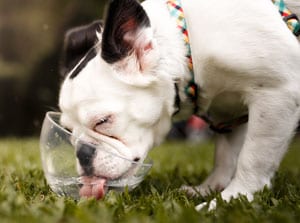Pet Heat Safety in Tulsa

Our pets are tireless companions who do everything they can to please us — whether or not it’s too hot for them. Dogs especially are enthusiastic people-pleasers and are outdoors with us more often than cats (unless your cat is primarily outdoors). During summers in Tulsa, our animals become more vulnerable to heat exhaustion and heatstroke and it’s up to us to give them the care they need to stay cool. Our veterinary hospital has come up with several pet heat safety tips to help you through the summer.
Tips for Keeping Your Pet Cool
- While it’s important to keep some breeds’ coats trimmed during the summer, you should never shave your dog or cat. Some fur actually helps to trap cooler air close to their body and it also prevents sunburn as well. Your veterinarian can help you decide what kind of trim will benefit your pet most.
- Never leave your pet in a parked car even on a mild day. The temperature inside a car can rise to over 100 degrees Fahrenheit in as little as 10 minutes. Don’t risk it. Leave your pet at home or take them out with you.
- Water and shade are your pet’s greatest friends during a hot summer’s day. If your pet is outdoors for any amount of time, ensure they have cool water in a bowl that can’t tip over as well as shade in which to rest.
- If your pet has to be outside for an extended period of time, a small kiddie wading pool filled with cool water will be a welcome relief!
- Do not leave your pet tethered when left outside. If their leash gets tangled, they could be stranded in the sun. Leave them free-range in an enclosed yard that’s well-ventilated with shade and a continuous supply of water.
- If you take daily walks with your dog or adventurous cat, try to go out earlier in the morning or later in the evening to avoid the hottest times of day.
- Steer clear of hot asphalt when out and about with your pet. Since they are much closer to the ground, the pavement can raise their body temperature significantly and the hot tar can burn their paws.
Recognizing Heat Exhaustion & Stroke
Heat exhaustion is the condition that preempts heatstroke. To prevent a bad situation from getting worse, it’s important to recognize signs of heat exhaustion and get your pet the care they need right away. Signs often include:
- Temperature of 104 degrees Fahrenheit or above
- Elevated heart rate
- Rapid breathing/panting
- Staring/unresponsiveness
- Staggering
In the case of a heatstroke, your pet may also experience:
- Seizures
- Bloody diarrhea
- Vomiting
- Collapse
- Organ damage
If you notice the signs of heat exhaustion, get your pet to cooler area immediately. Place cool, wet towels around their neck, belly, and groin area to help them cool down and contact your veterinarian as soon as possible. It’s important for your pet to be seen at a veterinary hospital sooner rather than later to ensure no lasting internal damage has been done. In the case of signs of heatstroke, don’t hesitate – bring them straight to our 24/7 emergency animal hospital.
For any questions about heatstroke in pets, please contact us at (918) 665-0508.
